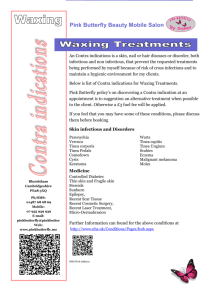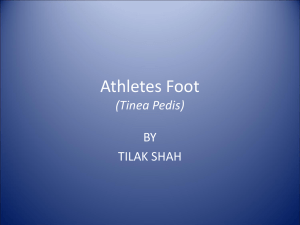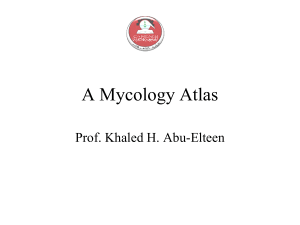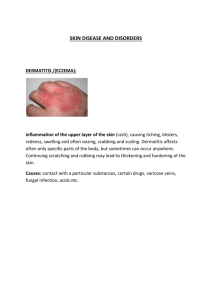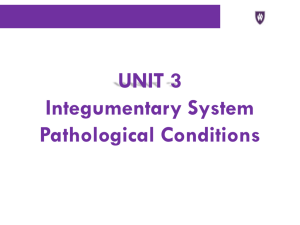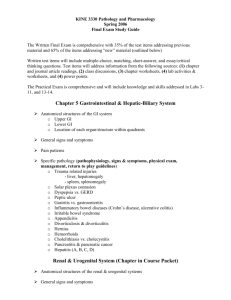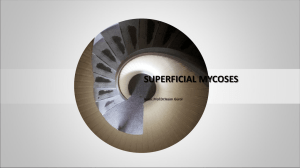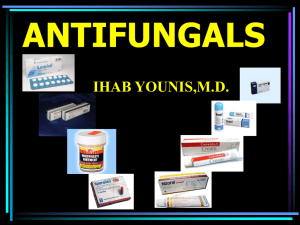Document
advertisement
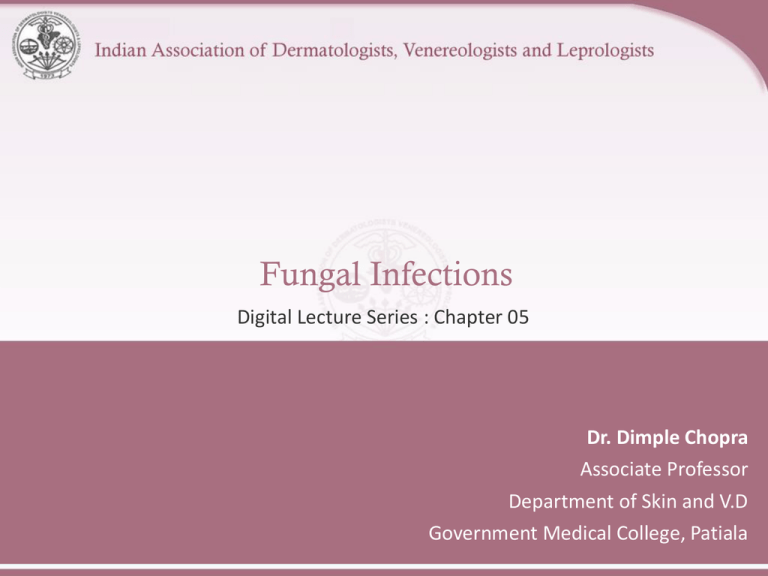
Fungal Infections Digital Lecture Series : Chapter 05 Dr. Dimple Chopra Associate Professor Department of Skin and V.D Government Medical College, Patiala CONTENTS Introduction Classification Superficial Fungal Infections• P. Versicolor • T. Nigra • Piedra • Dermatophytosis • Candidiasis Subcutaneous Fungal Infection• Mycetoma • Chromoblastomycosis • Sporotrichosis Systemic Fungal Infection • Histoplasmosis • Blastomycosis • Systemic Candidiasis • Coccidiodomycosis • Paracoccidiodomycosis • Cryptococcosis • Opportunistic Infections MCQs Photo Quiz Common cutaneous fungal infection Superficial - Due to fungi that involve fully keratinized tissue i.e. stratum corneum, hair and nails. Subcutaneous- These are the fungal infections that involve dermis and subcutaneous tissue. Deep mycoses - These involve the internal organs of the body along with the skin. Superficial mycosis of skin Minimal, if any, inflammation Inflammatory response common Cutaneous disorder Pathogen(s) Pityriasis(tinea) versicolor Malassezia furfur, M.globosa Tinea nigra Hortaea werneckii Black piedra Piedraria hortae White piedra Trichosporon beigelli Tinea capitis, barbae, faciei, corporis, cruris, manuum, pedis Trichophyton, Microsporum, Epidermophyton Cutaneous candidiasis Candida albicans, other Candida spp. Predisposing factors Tropical climate Manual labour population Low socioeconomic status Profuse sweating Friction with clothes, synthetic innerwear Malnourishment Immunosuppressed patients - HIV, diabetes mellitus, congenital immuno - deficiencies, patients on corticosteroids, immunosuppressive drugs Pityriasis versicolor Etiologic agent : Malassezia furfur Clinical features : Common among youth Multiple, discrete, discoloured, macules. Brown (hyperpigmented), grey or whitish - tan (hypopigmented) Pinhead sized to large sheets of discolouration Seborrheic areas : upper trunk and shoulder and arms Less frequently face (especially in children), scalp, anticubital fossae, submammary region and groin. P. versicolor Inverse P. versicolor – involvement of flexural areas Hypopigmentation is due to inhibitory effects of dicarboxylic acid on melanocytes Wood’s Lamp examination : Yellow fluorescence KOH preparation : • Spaghetti and meatball appearance • Coarse mycelium, fragmented to short filaments 2-5 micron wide and up to 2-5 micron long, together with spherical, thick-walled yeasts 2-8 micron in diameter, arranged in grape like fashion. P. versicolor On KOH mount Pityrosporum folliculitis Etiology : Malassezia furfur & M. globosa Age group : Teenagers or young adult females Clinical features : Pruritic, monomorphic ,follicular papules and pustules scattered on the shoulders and back. KOH : only yeast forms - no hyphal forms. Tinea nigra palmaris Etiology : Exophiala werneckii Clinical features : Single sharply marginated, brown or grey-green patch, velvety/mild scaling. Asymptomatic superficial infection of palms; resembling a silver nitrate stain. Piedra It is superficial fungal infection of hair shaft White piedra Black piedra Causative organism Trichosporon beigelii Piedraia hortae Nodule colour White( occasionally red, green or light brown) Brown to black Nodule firmness Soft Hard Nodule adherence to the Loose shaft Typical anatomical location Face, axillae and pubic region (occasionally scalp) Firm Scalp and face (occasionally pubic region) Piedra It is superficial fungal infection of hair shaft White piedra Black piedra Favoured climate tropical tropical KOH examination of “crush prep“ of cut hair shaft Non dematiaceous hyphae with blastoconidia and arthroconidia Demacious hyphae with asci and ascospores Culture on SDA Moist cream coloured yeast like colonies Slow growing, dark green to dark brown- black colonies Dermatophytosis These are fungal infections that invade and multiply within keratinised tissueskin, hair & nails Category Mode of transmission Typical clinical features Anthropophilic Human to human Mild to noninflammatory, chronic Etiological agents T. rubrum T. tonsurans T. concentricum T. mentagrophytes (var. interdigitale) Epidermophyton floccosum Dermatophytosis These are fungal infections that invade and multiply within keratinised tissueskin, hair & nails Category Mode of transmission Typical clinical features Zoophilic Animal to human Intense inflammation (pustules and vesicles possible), acute T. mentagrophytes (var.mentagrophytes) Microsporum canis T. Verrucosum Geophilic Soil to human or animal Moderate inflammation M. gypseum Etiological agents Pathogenesis Contact host factors Adherence Keratinases Invasion of fungi in stratum corneum Protease inhibitors, β-globulins, Mannans Inhibitory factors-sebum, ferritin Disease Dermatophytosis (Ringworm) Terminology : Head : Tinea capitis Face : Tinea faciei Beard : Tinea barbae Trunk / body : Tinea corporis Groin / gluteal folds : Tinea cruris Palms : Tinea manuum Soles : Tinea pedis Nail : Tinea unguium Tinea Corporis Dermatophytosis of the trunk and extremities with the exclusion of the palms (tinea manuum), soles (tinea pedis) and groins (tinea cruris). Incubation period- 1-3 weeks. All species of dermatophytes can cause this. Three most common causative organisms are T.rubrum> T. mentagrophytes > M. canis. In India, T. rubrum is most common. Tinea Corporis Centrifugally spreading from point of skin invasion with centrally clearing, a typically annular lesion (ring like) Morphological variants - arcuate, circinate & oval Clinical variants • Tinea profunda • Majocchi’s granuloma • Tinea imbricata Classical Tinea Corporis Recalcitrant and eczematized Tinea Corporis Differential diagnosis Nummular eczema Petaloid type of seborrheic dermatitis Pityriasis rosea Parapsoriasis Erythema annulare Subacute lupus erythematosus Granuloma annulare Annular psoriasis Tinea cruris Dermatophyte infection of inguinal region Area of erythema and pruritus in fold between scrotum & inner thigh Characteristic sharply demarcated with raised, erythematous, scaly advancing border that may contain pustules and vesicles Tinea manuum Dermatophytic infection of palm and interdigital space. Reason for different clinical picturerelated to lack of sebaceous glands on palm. Two varieties : Non inflammatory : Dry, scaly, mildly itchy Inflammatory : Vesicular, itchy Tinea faciei Erythematous scaly patches on the face Annular or circinate lesions and induration with pustules on border Itching, burning and exacerbation after sun exposure Almost always associated with tinea of other body parts Seen often in immunocompromised adults Tinea barbae Dermatophytosis of the bearded areas of face and neck Highly inflammatory, pustular folliculitis as caused by mainly zoophilic fungus Hairs of the beard or moustache are surrounded by inflammatory papulo-pustules, usually with oozing or crusting, easily pluckable Complications - abscesses, sinus tracts, bacterial super-infections , kerion like boggy swellings, alopecia D/D - Sycosis barbae, Acne vulgaris, Pseudofolliculitis Tinea Barbae Tinea capitis Infection of the scalp and hair Commonest mycosis observed in children Caused by dermatophytes in the genera Microsporum and Trichophyton. Epidermophyton is not traditionally isolated In North America T. tonsurans is most common while in Europe, M. canis is the most common agent TYPES : Non-inflammatory : Gray patch , Black dot Inflammatory : Favus , Kerion Tinea capitis Three patterns of invasion exist; Endothrix pattern - infection with anthropophillic fungi by non- fluorescent anthroconidia within hair shaft T. tonsurans, T. violaceum Ectothrix pattern- anthroconidia formed from fragmented hyphae outside the hair shaft, fluorescent or non fluorescent. Favus - hyphae and air spaces within the hair shaft and a bluish-white fluorescence. Gray patch Ectothrix pattern of invasion Patches of partial hair loss Often circular in shape Numerous “broken-off” hairs that are dull grey and lustreless due to the overcoating by arthrospores Causes epidemics in schools Etiologic Agent : Microsporum audouinii Asymptomatic or complain of mild itching Tinea capitis Black dot tinea capitis Endothrix pattern of invasion. Hair shaft is brittle and breaks at the level of the scalp, remnant of the hair left behind in the infected follicle appears as a black dot on clinical examination Diffuse scaling with minimal hair loss or inflammation Affected areas of hair loss are characteristically multiple and polygonal in outline with distinct finger like margins. Commonly spare some hair within the areas of involvement Black dot tinea capitis Kerion Mostly due to infection with T. verrucosum or T. mentagrophytes. Inflammed boggy and indurated tender swelling that is studded with broken or unbroken hairs, vesicles and pustules. Sinus formation and thick crusting with matting of adjacent hair Lymphadenopathy and secondary bacterial infection Heals with scarring & autoeczematisation(id eruption) Kerion Favus A yellow cup shaped crust composed of a dense mat of mycelia and epithelial debris called scutulum (shaped like a shield) The scutulae enlarge and merge to form prominent yellowish crusts. Characteristic mousy odour Borders of the infected lesions represent areas of advancing disease and are often polycyclic in shape & centre of the infected area gradually becomes extensively scarred and almost totally devoid of hair. Later stage - cicatricial alopecia. Commonest cause - T. schoenleinii Tinea pedis Type Causative organism Clinical features Moccasin T. rubrum E. floccosum Diffuse hyperkeratosis, erythema, scaling and fissures on one or both plantar surfaces Interdigital T. mentagrophytes (var. interdigitale) T. rubrum E. floccosum Most common type, erythema, scaling, fissures and maceration in web spaces, pruritus common, extend to dorsum and sole of foot Tinea pedis Type Causative organism Clinical features Inflammatory (vesicular) T. mentagrophytes (var. mentagrophytes) Vesicles and bullae on medial foot; associated with dermatophytid reaction Ulcerative T. rubrum T. mentagrophytes E. floccosum Exacerbation of interdigital tinea pedis; ulcers and erosions on web spaces; secondary infection with bacteria Tinea pedis Tinea unguium Onychomycosis - all fungal infections of nails including dermatophytes and non-dermatophytes. Tinea unguium - Dermatophytic Onychomycosis Dirty, dull, dry, pitted, ridged, split, discoloured, thick, uneven, nails with subungual hyperkeratosis. Different types described depending on the site of nail involvement and its depth. Distal and lateral onychomycosis Proximal subungual onychomycosis White superficial onychomycosis Total dystrophic onychomycosis Tinea unguium Toenail > Fingernail Men > Women Trauma - predisposing factor Most common pathogens T. rubrum, T. mentagrophytes E. floccosum Treatment Topical : Clotrimazole cream Ketoconazole cream Miconazole cream Econazole cream Sertaconazole Luliconazole Amlorifine Oral Treatment Oral drug Dose Fluconazole 150-200mg per week Griesofulvin 500-750 mg/ day Itraconazole 200-400 mg/day Terbinafine 250 mg o.d. Duration of Treatment Condition Duration Tinea corporis 4-6 weeks Tinea cruris 2-4 weeks Tinea manuum 1-4 weeks Tinea faciei 4-6 weeks Tinea pedis 4-8 weeks Tinea capitis 6-8 weeks Tinea unguium Finger nails : Toe nails : 12-24 weeks 24- 36 weeks Candidiasis Causative organism : Candida albicans, Candida krusei, Candida parapsilosis, Candida tropicalis, Candida pseudotropicalis. Sites of Carriage : Cutaneous Gastrointestinal Vaginal Sites of affection : Mucous membrane Oral candidiasis, Vulval candidiasis, Candidial Balanitis Skin Nails Candidiasis Oral Candidiasis : It can present as : Thrush (white exudates resembling cottage cheese; pseudo membranous form) As a patch of erythema (Chronic Atrophic form) Adherent white plaques(Chronic Hyperplasic type) Sites : Immuno-competent patient: cheeks, gums or palate Immuno-compromised patient: affection of tongue with extension to pharynx or oesophagus; ulcerative lesions may occur Candidiasis Angular cheilitis (perleche) : Soreness at the angles of mouth Vulvovaginitis : Itching and soreness with a thick ,creamy white discharge. Balanoposthitis : Tiny papules on the glans penis after intercourse, evolve as white pustules or vesicles and rupture. Radial fissures on glans penis in diabetics. Vulvovaginitis in conjugal partner. Oral Candidiasis Flexural Candidiasis Intertrigo : Retention of moisture, increased temperature and maceration in the folds favour the growth of candida in these areas. Napkin rash: Pustules with an irregular border and satellite lesions. Candidiasis: nail Chronic Paronychia : Swelling of the nail fold with pain and discharge of pus. Chronic ,recurrent. Superadded bacterial infection. Onychomycosis : destruction of nail plate. Treatment Treat the predisposing factors like poor hygiene, diabetes, AIDS, conjugal infection. Topical : Clotrimazole, Miconazole, Ketoconazole, Ciclopiroxolamine. Oral : Ketconazole 200mg (1-2 weeks), Itraconazole 100-200mg (2-3 weeks) and Fluconazole 150 mg (1 week) Subcutaneous fungal infections These are the fungal infections that involve dermis and subcutaneous tissue Mycetoma Chromoblastomycosis Sporotrichosis Mycetoma-Madura foot Clinical features : Triad - tumefaction, sinuses and grains. Chronic granulomatous swelling predominantly of feet with discharge of grains of varying shades. Foot > hand, trunk, scalp. Colour, consistency and feel of the granules help to differentiate the cause. Blackish brown grains - fungal etiology. The foot is usually deformed and secondary infection by bacteria may occur. Mycetoma-Madura foot Causative organisms Eumycotic mycetoma Actinomycetoma Madurella mycetomatis Streptomyces somaliensis Madurella grisea Actinomadura pelletieri Acremonium spp Actinomadura madurae Exophiala jeanselmei Nocardia asteroides Nocardia brasiliensis Eumycotic mycetoma Actinomycotic mycetoma Slowly invasive Rapidy invasive Late presentation, as it is relatively asymptomatic Early presentation No pus Pus present Black brown granules Granules yellowish white More deformity Less deformity Granules 4-5 micron, in clusters Granules < 1 micron lie singly Gram -ve GMS, PAS +ve Gram + ve ,GMS PAS – ve Responds to antibiotics Responds to antifungals (sulphonamides, doxyclines) (Itraconazole, amphotericin B) Chromoblastomycosis A chronic fungal infection of skin and subcutaneous tissue Verrucous dermatosis Cladosporiosis Organisms : Phialophora verrucosa, P. pedrosoi, P. compactum, Wangiella dermatitidis, Cladosporium carrionii, Fonsecaea sp. Chromoblastomycosis Clinical Features: Warty papule enlarges to expanding verrucous plaque; commonly on feet, legs, neck, face. Lower > upper extremity. Men 20-60 years. Tropical climate> Temperate climate. Farmers, miners at higher risk- exposure to soil and decaying plants and wood. Biopsy : Copper pennies, Medlar bodies, Sclerotic bodies. Treatment : Surgical excision, Cryotherapy, Amphotericin B, Itraconazole Chromoblastomycosis Sporotrichosis Rose gardener’s disease Caused by Sporothrix schenckii-dimorphic fungus. Clinical features: Localized lymphatic variety- Sporotrichoid pattern; chancre, ulcerated nodules in a linear arrangement along the lymphatics. Uncommon: acneiform, nodular, verrucous lesions. Hematogenous spread leads to systemic infection in lungs, muscles, bones, CNS. Treatment: Potassium iodide, IV Amphotericin B, IV Miconazole / Ketoconazole, oral Itraconazole. Sporotrichosis Single papule at the site of injury (mostly hands) Erosion, ulceration, purulent drainage (generally not painful) Dermal and subcutaneous nodules along path of lymphatic drainage Biopsy-Cigar shaped yeast cells with PAS and Silver stains. Treatment : Potassium iodide, IV Amphotericin B, IV Miconazole / Ketoconazole, oral Itraconazole. Systemic fungal infection These are divided in two groups Endemic mycosis : may involve any of the internal organs of the body along with the skin. Opportunistic mycosis : occur in immunosuppressive states. Histoplasmosis An infection caused by Histoplasma capsulatum -dimorphic fungus. Systemic fungal infection. Clinical features : Affects lungs, skin, reticulo-endothelial system, CNS, kidney. Similar to TB: Presentation can be acute/ chronic Pulmonary & disseminated types. Histoplasmosis Primary cutaneous infection: Papules, ulcers, nodules, granulomas, abscesses, fistulae, scars and pigmentary changes. Diagnosis : Biopsy-parasitized macrophages Blood, Bone marrow aspiration, FNAC Treatment : Itraconazole, ketoconazole, Amphotericin B. Blastomycosis Chronic granulomatous and suppurative mycosis by dimorphic fungus, Blastomyces dermatitidis. Clinical features : Affects lungs, skin, bones, CNS Primary cutaneous occurs following trauma-papulopustules and verrucous plaques with scales and crusting. Central ulceration and cribriform scarring. Adult men-Systemic infection more common. Children-Acute pulmonary . Exposure to soil. Blastomycosis Diagnosis : KOH mount -Broad -based budding, thick double contoured walls. Biopsy Culture Treatment : Itraconazole Ketoconazole, Fluconazole, Iodides Amphotericin B Systemic Candidiasis Immuno-compromised patients develop macules, papules or nodules with a pale centre. Some may become haemorrhagic. Some may develop a syndrome of Chronic Mucocutaneous Candidiasis and Paronychia. Treatment : IV Amphotericin B Fluconazole Coccidioidomycosis Also known as - Posada’s disease, San Joaquin’s Valley fever, Desert Rheumatism Primarily a respiratory fungal infection caused by Coccidioides immitis. Clinical features : Respiratory tract infection, may develop an acute disseminated fatal form. Cutaneous manifestations-papules, pustules, plaques, abscess and sinus tracts with face being the most common site of involvement. Coccidioidomycosis Diagnosis : KOH mount-Barrel shaped anthroconidia Histology Serological tests Treatment : Self limiting in majority of cases. Amphotericin B, Ketoconazole, Itraconazole, Miconazole can be given. Paracoccidioidomycosis Also known as South American Blastomycosis, Brazilian Blastomycosis Paracoccidioides brasiliensis causes chronic granulomatous infection. Clinical Features : Mucocutaneous involvement is seen in progressive disseminated disease. Lesions are often painful and ulcerative. Nasal and oral mucosa most commonly involved. Treatment : Fluconazole, Ketoconazole, Itraconazole (drug of choice) Cryptococcosis Caused by Cryptococcus neoformans - affects brain, lungs and skin. Mostly associated with immunodeficiency syndrome. Clinical features : Meningitis, focal neurological deficit. Cutaneous findings-Firm cystic EN- like lesions, acneiform lesions, umblicated papules, plaques and nodules. Molluscum contagiosum like lesions. Diagnosis : Microscopy - India ink preparation Treatment : Fluconazole- first line of therapy. Amphotericin B and Flucytosine combination for severe meningeal and systemic disease. Opportunistic fungal infections Mycosis Common cutaneous presentation Systemic Candidiasis Firm erythematous papule and nodule with pale centre Aspergillosis Necrotic papulonodules, Subcutaneous nodules Disseminated disease from primary pulmonary involvement. Zygomycosis Ecthyma gangrenosum like lesions, cellulitis, facial edema, plaques, large haemorrhagic crusts on face Cryptococcosis Ulceration, cellulitis, Molluscum contagiosum like lesions Opportunistic fungal infections Mycosis Common cutaneous presentation Subcutaneous cysts, ulcerated plaques, Phaeohyphomycosis haemorrhagic pustules, necrotic papulonodules Hyalohyphomyosis Umblicated or necrotic papulopustules, abcesses, cellulitis, subcutaneous nodules, Trichosporonosis Papulovesicles, purpuric papules, necrotic papulonodules MCQ’s Q.1) Most common type of tinea unguium in HIV patients A. Distal and lateral B. Proximal subungual C. White superficial D. Total dystrophic Q.2) Rose gardener’s disease is A. Sporotrichosis B. Chromoblastocosis C. Histoplasmosis D. Blastomycosis MCQ’s Q.3) Which is diagnosed by Indian Ink preparation? A. Histoplasma capsulatum B. Cryptococcus neoformans C. Candida tropicalis D. Coccidiodes immitis Q.4) Which of the following is Geophillic fungus? A. T. Tonsurans B. T. Concenticum C. M. Gypseum D. Microsporum canis MCQ’s Q.5) “Spaghetti and meatball” appearance is seen in A. Piedra B. Tinea nigra C. P. versicolor D. Chromoblastomycosis Q.6) Which of the following called Jock’s itch? A. Tinea cruris B. Tinea corporis C. Tinea pedis D. Tinea unguum Photo Quiz Q. 7) Identify the condition Photo Quiz Q.8) Identify the condition Q. 9) Identify the condition Thank You!
